LG G2 and MSM8974 Snapdragon 800 - Mini Review
by Brian Klug on September 7, 2013 1:11 AM EST- Posted in
- Smartphones
- LG
- Mobile
- LG G2
- Android 4.2
- MSM8974
- Snapdragon 800
CPU Performance
LG's G2 features a quad-core Snapdragon 800 SoC (MSM8974). For a quick refresher, Snapdragon 800 features four Krait 400 cores running at up to 2.3GHz courtesy of TSMC's 28nm HPM process. The 2.3GHz max clock speed comes at a surprisingly low voltage thanks to the low power HPM process. Gone are the days of 1.4V to hit near-2GHz frequencies it seems, instead 8974 will hit 2.3 GHz at around 1V. Krait 400 improves L2 access latencies over Krait 300 (which is at the heart of Snapdragon 600 and S4 Pro) and is optimized for higher frequency operation, but Krait 400 is otherwise architecturally similar to Krait 300. Make no mistake, MSM8974 is the new high-end, pushing Snapdragon 600 and S4 Pro parts further down into midrange category. There are other SoC level enhancements as well, including things like a new version of the Hexagon DSP and obviously Adreno 330 vs. Adreno 320 (which I'll get to later). We already ran through a performance preview of Snapdragon 800/MSM8974 using Qualcomm's 8974 Tablet Mobile Development Platform, but today we get to do the same with the G2.
LG was pretty eager to get us a G2 sample as early as possible, unfortunately that comes at the expense of software maturity. LG made it very clear to us that the International G2 sample (LG-D802) we received has nowhere near final software, and as a result may not deliver performance indicative of what we'll see when the device shows up later this month. This puts us in an interesting situation as we want to see how close shipping Snapdragon 800 devices come to the Snapdragon MDP/T we tested back in June. Software maturity aside, there's no skirting the fact that the G2 simply has a smaller chassis and perhaps lower thermal limits than the tablet MSM8974 MDP/T we tested previously.
The most interesting comparison points here will be to LG's Optimus G Pro which ships with a Snapdragon 600 (4 x Krait 300 running at 1.7GHz), the Exynos 5 Octa based Galaxy S 4 (SHVE300S) and to the MDP/T. As always, we'll start with a look at CPU performance.
The state of CPU performance testing under Android is unfortunately still quite broken. We're using a mix of browser based tests with Java & Native apps (AndEBench).
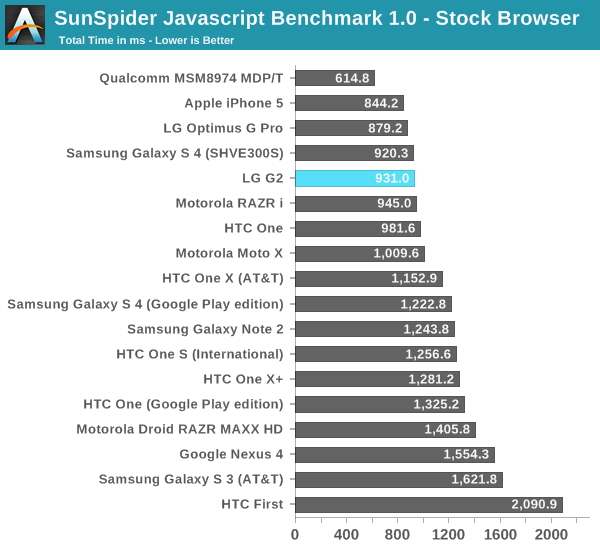
SunSpider has quickly become an exercise in browser optimization rather than platform performance. Qualcomm's browser optimizations are clearly good for showing off Snapdragon 800's potential, however the G2 doesn't appear to have the same optimizations in place (yet). Performance isn't bad, but it's merely on par with Snapdragon 600 and ARM's Cortex A15.
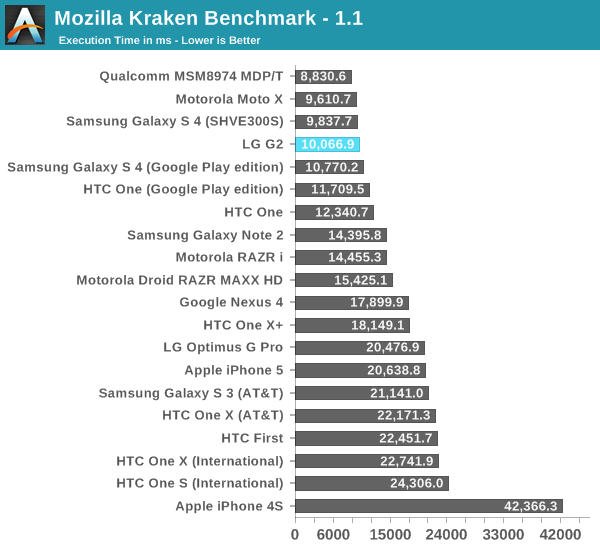
Kraken is an interesting test as it has (thus far) remained less of a browser optimization target. Kraken is also a physically larger and longer benchmark, which provides results that I tend to be a little happier with. The G2 once again falls short of Qualcomm's MDP/T, but given its early software I'm not too surprised. Performance is roughly on par with the Exynos 5 Octa, and slightly behind the very high clocked Snapdragon 600 in the nearly stock Moto X.

Octane is the first benchmark where we see the Snapdragon 800 flex its potential. Here the G2 not only ties the Snapdragon 800 MDP/T, but it also roughly equals the performance of the Cortex A15 based Exynos 5 Octa. Ultimately that's the comparison that Qualcomm will be most interested in winning. If Snapdragon 800 can deliver better performance (or at least perf per watt) than the Cortex A15, it'll be a definite win for Qualcomm.
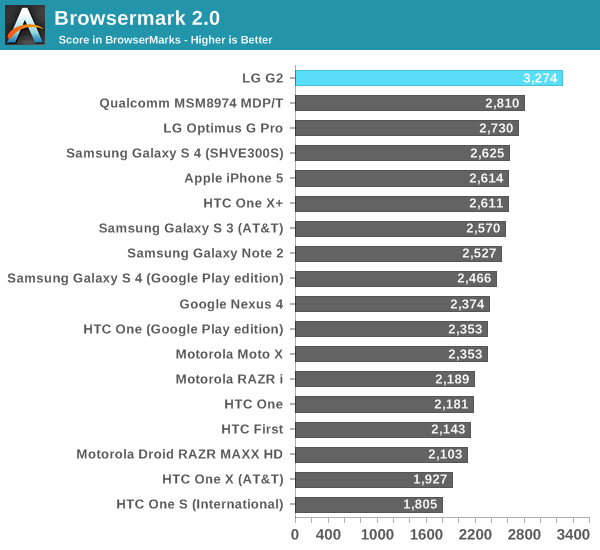
If Octane had the S800 in the proverbial passing lane, Browsermark 2.0 shows the G2 in the clear lead. Here LG was able to even outperform Qualcomm's own reference design by 16%. I suspect this has more to do with browser optimizations than anything else though, as the S600 based Optimus G Pro also does extremely well.
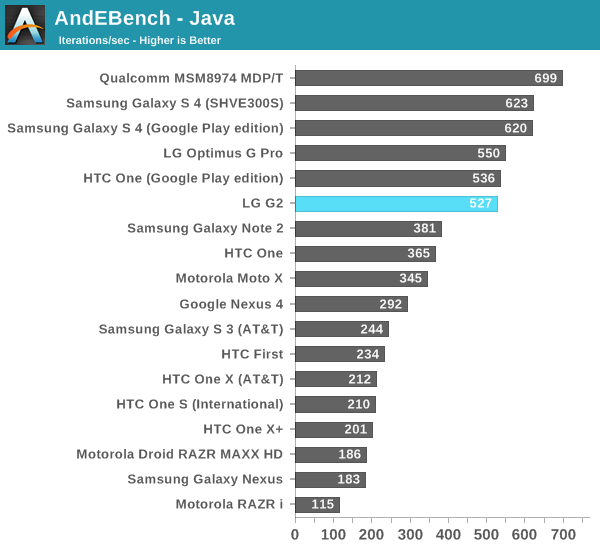
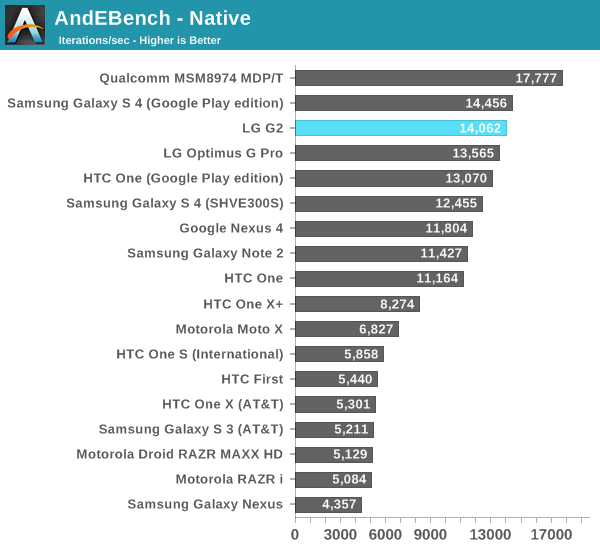
AndEBench provides us with very low level look at SoC performance. I'm not a huge fan of these types of tests, especially ones that aggregate a bunch of microbenchmarks and attempt to present a single performance number. AndEBench is unique (and useful) in that it presents performance in both native code and Dalvik interpreted states. The G2's native performance here is quite good, but it's actually equalled by the Galaxy S 4 GPe and not far ahead of the Optimus G Pro. I suspect we're once again seeing the limits of early software rather than a full understanding of Snapdragon 800's performance in a retail device. Dalvik performance is a bit worse. The relatively high ranking of the Google Play Edition devices points to software optimization being a culprit here.
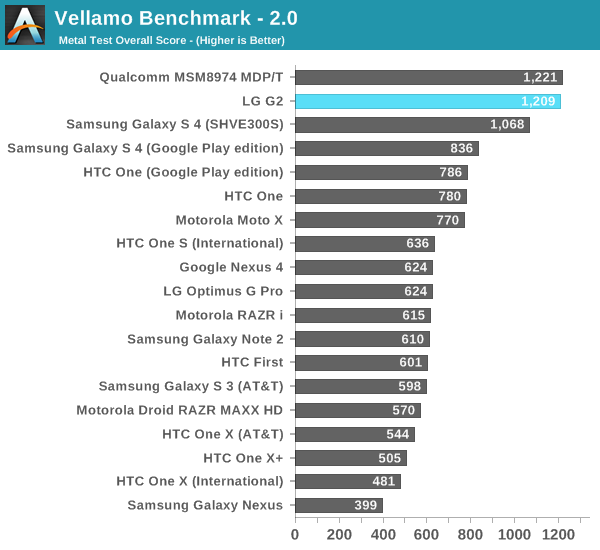

Both Vellamo tests put the G2 on par with Qualcomm's Snapdragon 800 MDP/T.








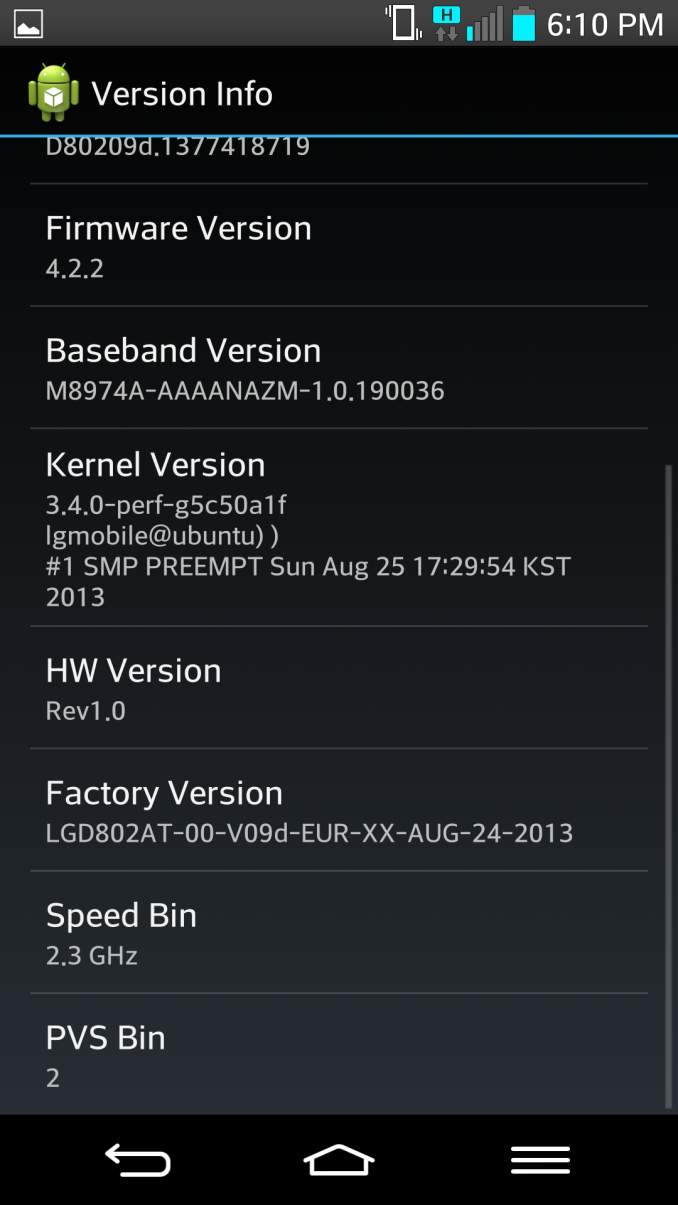
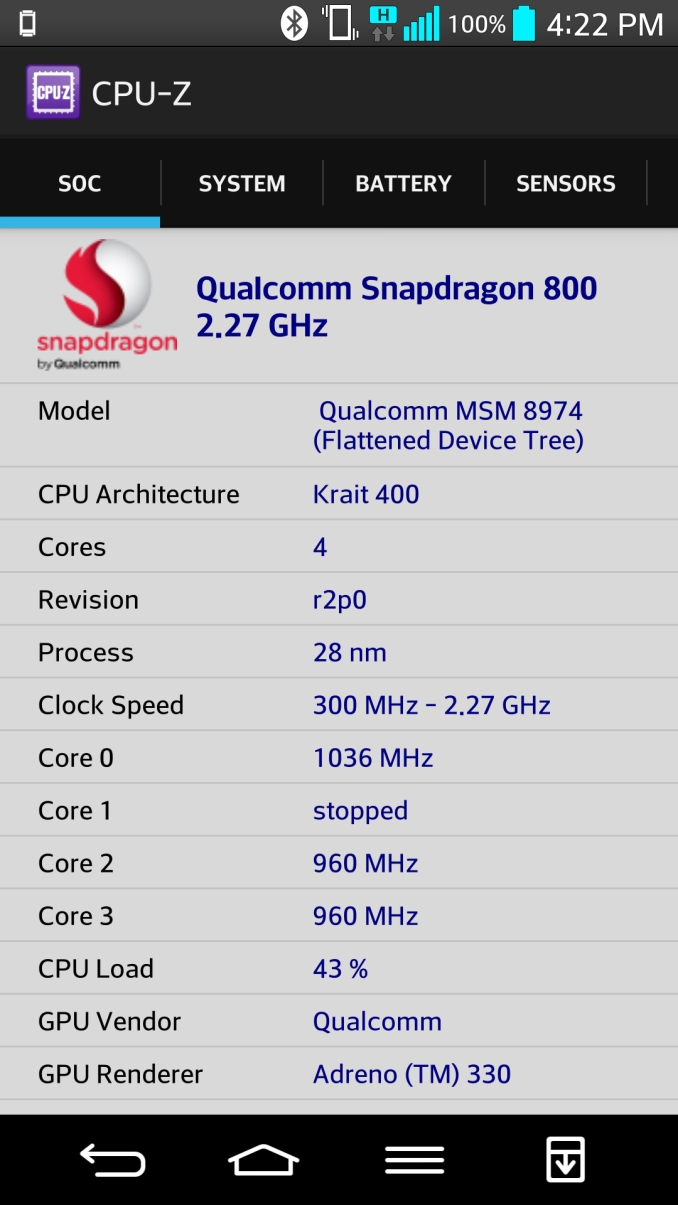








120 Comments
View All Comments
ijozic - Saturday, September 7, 2013 - link
Would love to see some audio quality tests and a comment on the volume levels (maybe in the full review?) as LG usually goes below average in this area..Impulses - Saturday, September 7, 2013 - link
SecondedBoneAT - Saturday, September 7, 2013 - link
It's interesting that the G2 either slightly over-exposes most situations, or the dynamic range is tighter than on the S4 Octa's Exmor RS and or the Lumia 1020, this applies to photos and videos alike. Otherwise I'm highly impressed with the camera performance, very natural, even slightly under-saturated results like the S4 Octa (which in the 808 comparison shows that it's everybody else over-saturating), I'd only set half a step lower exposition correction and let everything else done by the device.Brian, what is the maximum exposure time you could get automatically or manually off a single shot? What is the highest ISO value?
Jon Tseng - Saturday, September 7, 2013 - link
Hmmm. So looks like trade off vs Nexus 5 (2300mah) will be great battery life vs OS updates. Tough one!On rear buttons I'm cool w that -used to have atrix w rear power button/fingerprint and no probs at all w day to day use.
andykins - Saturday, September 7, 2013 - link
Don't forget the biggest difference (imo): price. The Nexus 5 should be around half the price.Alketi - Saturday, September 7, 2013 - link
This actually bodes *very* well for the Nexus 5, as it also packs a Snapdragon 800 chipset.It's not too much of a stretch to expect better battery life than the Nexus 4, which was already decent. Plus, there's a good chance of an upside surprise, if it also packs the panel self-refresh and gets gains from Android 4.4.
Spunjji - Monday, September 9, 2013 - link
One thing worth bearing in mind is that even with ~75% of the battery capacity the G2 would still have class-leading battery life. So, the Nexus 5 is hardly going to stink in that regard!Krysto - Saturday, September 7, 2013 - link
Great to see those battery efficiency improvements from Qualcomm. You'd following the right path here, Qualcomm. Please don't change.Nvidia is stupid for following the "pure performance" path. That strategy has lost them most customers, especially since they followed that strategy to the point where they were making only "tablet chips", which is code-word for "our chips aren't efficient enough for smartphones".
I've said it before, chip makers should think about making "smartphone chips" first and foremost, and THEN, use the same chips, maybe with a little extra clock speed in tablets, too. If think think about making "tablet chips", they will blow it, because they will make the chip too inefficient and won't be able to "downscale" as easily to put it in smartphones.
So yeah, Qualcomm please continue doing your own thing. If Nvidia, Samsung and others keep following the "performance/benchmark" path, then the joke is on them, and will ultimately fail (as they have so far, and it's most devices are using Qualcomm's chips). I do hope they wake up to it sooner rather than later though, because I don't want Qualcomm to become another monopolistic Intel.
UpSpin - Saturday, September 7, 2013 - link
Qualcomm is the only Android SoC producer which does design their own cores and does not rely on ARM finished CPU designs.If you take a close look, you'll see that the Tegra 4 and the Exyons 5 are the only A15 processors at the moment, and it probably took much longer for ARM to release them and for NVIDIA and Samsung to finalize them than expected. They also had no other option than A15 to get some improvement over A9 and to remain competive with future Qualcomm SoCs.
Qualcomm on the other hand was able to release minor updates the whole time, so processors between A9 and A15.
Samsung will do the same next year, so expect some larger competition to Qualcomm.
Qualcomm also has the big radio advantage, which NVIDIA adressed with the i500 and which might make them competive to Qualcomm next year again.
Neither Samsung nor NVIDIA followed a performance strategy only. They had no other choice than using A15, and Tegra, as always used their 4+1, Samsung had to use big.LITTLE to make A15 usable in a smartphone. But big.LITTLE wasn't fully ready yet, so they had no other choice than using an octa-core setup.
And also remember that MIPS (a competive contender to ARM, but so far mostly used in low end applications) got bought up by Imagination Technologies, which I strongly believe will try everything they can to push MIPS in the high end sector.
So I think it's safe to assume that there won't be a monopoly, Qualcomm just had a big advantage for one year because of the A9 to A15 gap and by offering integrated radios. Both Samsung and NVIDIA learned from this, and a new competitior to ARM is coming up, too.
So it will get really interesting.
Impulses - Saturday, September 7, 2013 - link
That one year advantage in design turned into two solid years of device wins for Qualcomm tho... It's gonna get interesting next year for sure.